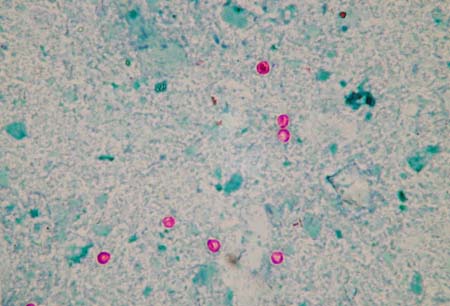Resumo
Definição
História e exame físico
Principais fatores diagnósticos
- presença de fatores de risco
- diarreia
Outros fatores diagnósticos
- dor abdominal
- vômitos
- perda de apetite
- febre baixa
- perda de peso
- dor abdominal no quadrante superior direito
- icterícia
- secreção nasal e dor facial
- tosse e dispneia
Fatores de risco
- contato com gado, especialmente bezerros e carneiros
- viagem internacional
- idade: 3 anos ou menos
- deficiência imune: mediada por células-T
- natação e esportes aquáticos recreacionais
- beber água não filtrada
- idas ao banheiro ou trocas de fraldas de crianças menores
- Desnutrição
Investigações diagnósticas
Primeiras investigações a serem solicitadas
- reação em cadeia da polimerase para identificar espécies de Cryptosporidium
- microscopia com coloração das fezes
- Detecção de antígeno de Cryptosporidium
Investigações a serem consideradas
- ultrassonografia do trato biliar
- tomografia computadorizada (TC) do trato biliar
- colangiopancreatografia retrógrada endoscópica (CPRE)
Algoritmo de tratamento
imunocompetentes
imunocomprometido
Colaboradores
Autores
Rachel M. Chalmers, BSc, PhD
Consultant Clinical Scientist/Honorary Professor
Director of the Cryptosporidium Reference Unit (England and Wales)
Public Health Wales Microbiology
Singleton Hospital
Swansea
UK
Declarações
RMC is an author of a number of references cited in this topic.
Angharad P. Davies, MA, MBBCh, MRCP, FRCPath, PhD
Clinical Associate Professor
College of Medicine
Swansea University
Swansea
UK
Declarações
APD is a Trustee Board Member for the Royal College of Pathologists and is an author of a number of references cited in this topic.
Revisores
Shauna Gunaratne, MD, MPH, DTM&H, CTropMed
Assistant Professor of Clinical Medicine
Department of Medicine
Division of Infectious Diseases
Columbia University Irving Medical Center
New York
NY
Declarações
SG declares that she has no competing interests.
Judy Streit, MD
Clinical Professor
University of Iowa Hospitals and Clinics
Iowa City
IA
Declarações
JS declares that she has no competing interests.
Créditos aos pareceristas
Os tópicos do BMJ Best Practice são constantemente atualizados, seguindo os desenvolvimentos das evidências e das diretrizes. Os pareceristas aqui listados revisaram o conteúdo pelo menos uma vez durante a história do tópico.
Declarações
As afiliações e declarações dos pareceristas referem--se ao momento da revisão.
Referências
Principais artigos
Centers for Disease Control and Prevention. CDC Yellow Book 2024: health information for international travel. Section 5: travel-associated infections and diseases - cryptosporidiosis. May 2023 [internet publication].Texto completo
Shane AL, Mody RK, Crump JA, et al. 2017 Infectious Diseases Society of America clinical practice guidelines for the diagnosis and management of infectious diarrhea. Clin Infect Dis. 2017 Nov 29;65(12):1963-73.Texto completo Resumo
National Institutes of Health, Centers for Disease Control and Prevention, HIV Medicine Association, and Infectious Diseases Society of America. Panel on Guideline for the Prevention and Treatment of Opportunistic Infections in Children with and Exposed to HIV. Guidelines for the prevention and treatment of opportunistic infections in children with and exposed to HIV: Cryptosporidiosis. 2019 [internet publication].Texto completo
National Institutes of Health, Centers for Disease Control and Prevention, HIV Medicine Association, and Infectious Diseases Society of America. Panel on Guidelines for the Prevention and Treatment of Opportunistic Infections in Adults and Adolescents with HIV. Guidelines for the prevention and treatment of opportunistic infections in adults and adolescents with HIV: cryptosporidiosis. 2023 [internet publication].Texto completo
Artigos de referência
Uma lista completa das fontes referenciadas neste tópico está disponível para os usuários com acesso total ao BMJ Best Practice.

Diagnósticos diferenciais
- Diarreia aguda
- Diarreia crônica
- Doença de Crohn
Mais Diagnósticos diferenciaisDiretrizes
- Health information for international travel (Yellow Book): cryptosporidiosis
- Prevention and treatment of opportunistic infections in adults and adolescents with HIV
Mais DiretrizesFolhetos informativos para os pacientes
Diarreia em crianças
Diarreia em adultos
Mais Folhetos informativos para os pacientesConectar-se ou assinar para acessar todo o BMJ Best Practice
O uso deste conteúdo está sujeito ao nosso aviso legal